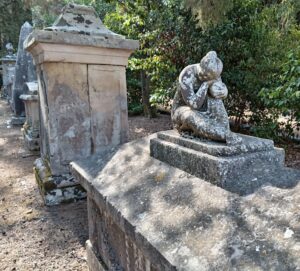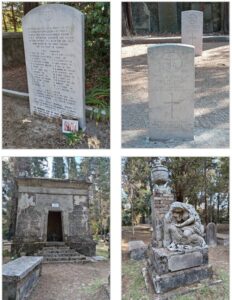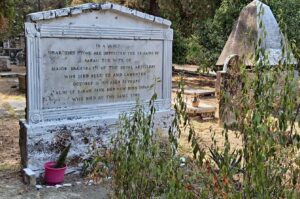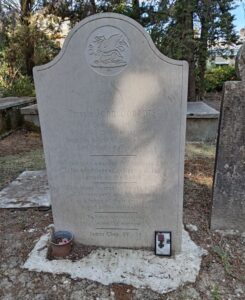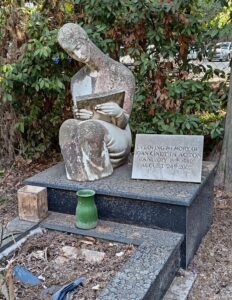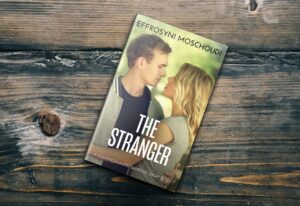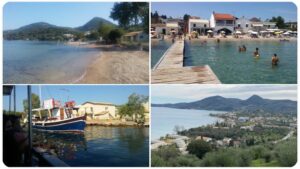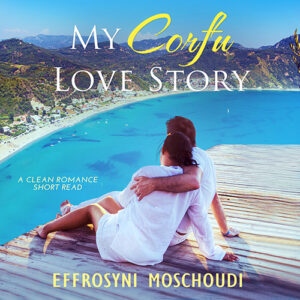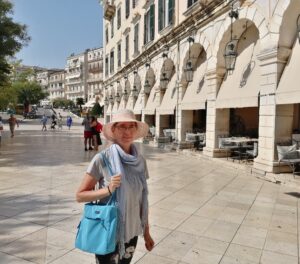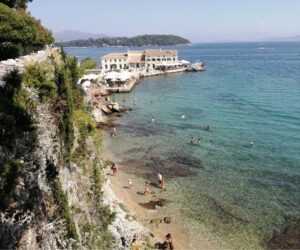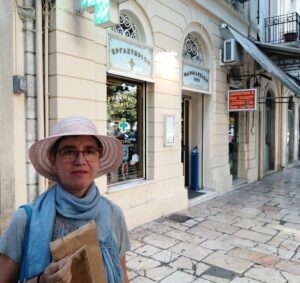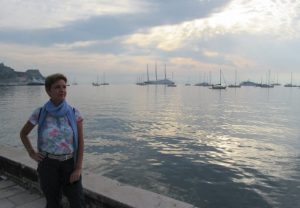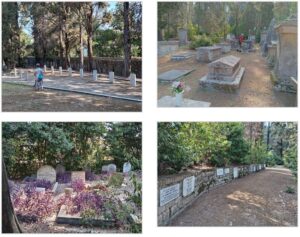 A shady and quiet part of town that was immensely interesting to explore
A shady and quiet part of town that was immensely interesting to explore
During my short vacation on the island of Corfu this summer, my husband and I visited The British Cemetery of Corfu for the first time. After a delightful but increasingly uncomfortable wander around the old town and its marvelous lanes because of the extreme heat, my notion to head to the cemetary for some shade and serenity, away from the crowds, proved to be an excellent choice.
The British Cemetery of Corfu is situated on Kolokotronis street, near San Rocco (Sarocco) Square, about a fifteen-minute walk from Liston.
At Sarocco, we stopped to ask for directions, and, lucky us, the woman we asked randomly turned out to be an Irish lady who lived in town. She eagerly provided directions, and even gave us information of the cemetery’s current, and rather unfortunate status. But I’ll tell you all about that in a minute. Let me start by giving you an idea of the place, and a bit of history…
The British cemetery of Corfu was opened as a military cemetery in about 1855, while the island was under British occupation. During the First World War, the island was used as a naval base, both by Great Britain and the United States. The cemetery contains 13 First World War burials and 16 from the Second World War. The latter are mostly casualties from two H.M.S. destroyers, Saumarez and Volage, that were mined by the Albanians in the Corfu Channel, off the coast of Albania, on October 22, 1946 (The Corfu Channel Incident).
I found the burial site from these two naval catastrophes particularly moving (see the top two photographs among the four above). A contemporary color photograph of four people, probably, all related to each other, lies inside a frame at the bottom of the memorial plaque. It makes it obvious to think that the heroes buried there are still being honored and remembered to this day by the later generations of their families. You can see a wide view of this burial site above, on the first set of photographs (I am pictured standing before it).
At this particular burial site, the Christian inscriptions at the bottom of many of the tombstones were particularly moving to read out–using beautiful rhymes, they express sentiments of heartache, and a hope for peace – both for the deceased and the living. Here are two of them:
“Time cannot change or even dim, the loving memories we have of him.”
“Peace, perfect peace, with loved ones far away, in Jesus keeping we are safe and they.”
Other than the burial site with the casualties from these two lost destroyers, the cemetery also features a collective grave of unidentified victims from the collision of H.M.S. Orwell in 1903.
We were surprised to find some German graves in the cemetery! No idea who and why, so if anyone has any info about this I’d love to know more. They were laid out together, about four or five of them. They weren’t marked by gravestones but by big wooden crosses, dating as far back as 1897.
Also, I’d like to mention that there is a small ossuary in the cemetery (see above, it’s the edifice on the lower part among the four photos, on the left).
“Sacred to the memory of…” was the beginning of most inscriptions I read from the 1800s. It was heart-breaking to read about the loss of so many lives at a young age, including those of newborn or small babies and of women losing their lives during labor. Such was the case for Sarah, the wife of Major Brandreth of the Royal Artillery. According to the inscription on her tomb (see above), she died “Beloved and Lamented” in 1819 during delivery at the age of 35, along with her baby.
In this photograph, perhaps you can make out the tiny frame at the bottom of the tombstone on the right. It contains the actual Victoria Cross medal awarded to the deceased, Private John Connors, for “conspicuous gallantry at the attack on the Redan” during the Crimean War. Connors, a private in the 3rd Regiment of Foot, died in 1857 “from the effect of a fall from the battlements at Port Neuf.”
At the bottom, the inscription reads, “Ye know not what shall be on the morrow. James chapter IV:14”
The remnant of the attentions to this hero by his surviving family members is hard to miss. If you look at the small empty tub that surely was once left at the grave with fragrant blooms inside it, perhaps you will see a spot of red color. It is a faded fabric poppy, the symbol of rememberance that the British still wear on their lapels once a year to honor their dead during the wars.
Other than the military graves during the two world wars, the cemetery also has a staggering 400+ non-war military and civilian graves.
Up until recently, the cemetery was still under the jurisdiction of the British War commission and it was well-maintained. Both flora and fauna thrived, and the gardens were well-clipped and lush.
Sadly, things changed back in 2023, when the British Ambassador to Greece announced that the complete jurisdiction of the British Cemetery was going to pass from the British War Commission to the Municipality of Corfu.
The latter committed to maintain the site and to continue to allow access to the relatives of the people buried in the cemetery.
However, once they took over, a ban on new burials was introduced with the exception of people who already had family plots there. Another newly applied restriction related to the visiting hours, which are now limited to 8:00 am to 1:00 pm, Monday to Friday, except for holidays.
This is particularly distressing to the British who wish to visit the graves and honor their dead out of this time window. Some of the Brits on the island who work are not able to visit on weekday mornings, and in general, the ban stops them from following some Orthodox traditions too, such as Psychosavvato (Soul Saturday) which calls for a blessing given by a priest at the grave, as well as other actions that honor the dead – i.e. lighting a candle at the grave, burning incense, or leaving some kolyva (wheat berry).
Note: To learn more about the tradition of Psychosavato and Greek Orthodox beliefs pertaining to the deceased and the afterlife, you are welcome to read this post on my blog.
Sadly, these are not the only inconveniences the British families of the deceased have to navigate. The place itself seems to be in a state of ruin and neglect these days compared to how it was before the take over. The situation is worse in the winter and the spring when the weeds grow waist-high and it becomes hard, if not impossible, to approach some of the graves. The British community on the island continues to push the Municipality of Corfu for a more effective gardening service, as well as for the care of the creatures that live in this beautiful natural space.
For many years, the British cemetery used to be under the care of the Psaila family, who lived in the residence inside the cemetery. The last caretaker before the take over by the Municipality of Corfu, was Mr. George Psailas, who took extra care of the orchids and other rare flowers in the gardens, as well as its living creatures, including many tortoises.
The cemetery used to be a paradise for the naturalists at the time. You may also be interested to know that some of the rare trees have been planted by none other than Mr. Theodore Stefanidis, the polymath and mentor of Gerald Durrell.
During my visit, I saw some cats at the lush, picturesque entrance of the cemetery, where the residence I just mentioned still stands. Outside, stood a friendly female council worker, who welcomed us cordially. In front of the building, I saw dishes with dry pellets left out for the cats and flower pots that were well-watered, so maybe some steps are being taken to the right direction.
Note: If you plan to visit the cemetery, please note that there are two entrances to it. The main one that has the sign with the opening hours was locked when we arrived. Thankfully, we noticed to the right another small entrance which was open and we used that to get in and out. Make sure to look for it if you also find the main gates closed!
Having visited in the height of summer, there were no weeds on the paths and the plots, though some of the graves in more remote parts could have been tidier. But, in general, the ground was clear. The two of us and the few other visitors we encountered wandered about on smooth ground. Sadly, all the trees (mostly, cypress trees) looked wilted, and, in some parts, so scorched, as if burnt by fire. Granted, it’s been a fierce summer, but hopefully, a more frequent watering would give new life to those poor old trees.
I hear the cemetery still has a tortoise population, but I regret to say I didn’t see any. Maybe, next time. I’ll definitely return to explore it further. The cemetery proved to be bigger than we thought and we ran out of time!
GO HERE to see all my photographs from The British Cemetery of Corfu.
How to get there:
From Sarocco Square, take Methodiou street (toward the airport). Just before the junction, take a sharp turn left into Kolokotronis street and you will see the cemetery on your left hand shortly. If you’re coming from the airport or the bus station, you pass the legendary Villa Rossa on your right hand (which is currently covered by scaffolding, by the way – finally, some maintenance work?). The junction is shortly after Villa Rossa. Turn right at the junction and then sharp right again to get to the cemetery. It is situated a short walk away from Sarocco and about half a mile from the bus station.
Please note: I do not know if you can drive according to my directions. I always park away from the center in the area of Villa Rossa. There’s parking on the residential streets across from it and a free municipal parking area too.
A final note: Many thanks to my Facebook friend, Jan Manessi, who provided some of the information I provide here.
THANK YOU FOR READING! MAKE SURE TO DOWNLOAD MY 3 FREE BOOKS BELOW 🙂 YOU WILL RECEIVE THEM INSTANTLY WITH YOUR SUBSCRIPTION TO MY FUTURE POSTS!
Sharing is caring! Here’s a ready tweet for you to spread some love:
The British cemetery of Corfu, a serene place steeped in history #Corfu #Corfutown #Corfuisland Share on X
3 FREE books for you! Sign up below to receive them instantly!
NEW! Clean Christmas romance. Single mother Cathy Roussos gave up on love long ago, and veterinarian Alex Rallis doesn’t believe in it, but one magical Christmas on a Santorini farm might just change everything…
Check it out on Amazon Read a FREE sample!
A clean romantic suspense short read with an unreliable narrator that’ll keep you guessing! Vera is losing her mind over famous actor Yannnis Ksenos, except, she isn’t just a fan… Now, she plucks up the courage to ring his doorbell… Visit Amazon
For my delicious Greek recipes, go here.
Planning to visit Greece? Check out my FREE guide to south Corfu!
Have you considered Amazon Prime? Other than offering free shipping on all your orders and fabulous streamed content, you’ll also have access to numerous other services, such as: Free grocery deliveries, free food deliveries with Grubhub+, exclusive medical care and prescription services, and more!
Start your FREE 30-day trial today

